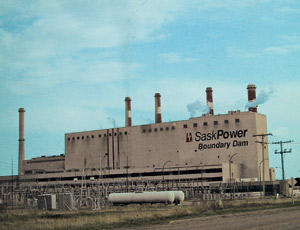Construction of what will be the first large-scale commercial carbon capture and storage project in the world began just hours after the Saskatchewan government gave SaskPower the go-ahead on April 26 to build the $1.24-billion plant. The project, at SaskPower's Boundary Dam coal plant, is notable not only for its size but also because it is moving forward at a time when other CCS projects are not because of CCS's high cost.

Mike Monea, a vice president of Sask- Power responsible for the project, insists, “The business case is sound for this project.” If completed as planned in 2014, the No. 3 unit at the plant will have an upgraded boiler and a new turbine in the existing building to produce 150 MW of electricity. About 40 MW of that power would be used to capture sulfur and capture and compress one million metric tons of carbon dioxide a year. Both of these products will be sold to help offset the cost of the plant.
SaskPower, which is owned by the province, was able to start work hours after approval was given because it has spent three years—and $240 million of federal money—conducting front-end engineering and design (FEED) work on the project with the help of Edmonton, Alberta-based Stantec Inc., Monea says. SaskPower analyzed several carbon-capture methods but settled on one developed by Cansolv, a unit of The Hague, Netherlands-based Shell Global Solutions.
The process uses an amine solution to capture carbon and sulfur. Boundary Dam will be the first demonstration of Cansolv's carbon-capture technology.
SaskPower selected Quebec-based SNC-Lavalin to oversee detailed engineering, procurement and construction for the project. Tokyo, Japan-based Hitachi will supply the generating turbine, the first in the world designed to fully integrate a coal-fired powerplant with carbon-capture technology. SaskPower is acting as the overall project manager.
Widespread deployment of CCS, including some promising new approaches, is more than a decade away, says Robert LaCount, senior director, climate change and clean energy, at IHS CERA.
Michael Arné—senior analyst at Englewood, Colo.-based IHS and author of the recently released “Carbon Capture and Storage: At a Critical Juncture”—says, “The scrubbing technologies currently moving through demonstration are very expensive, and it's hard to see how to significantly bring down their cost.”
In December, Bismarck, N.D.-based Basin Electric postponed carbon-capture plans for its Beulah, N.D.-Antelope Valley Station because the cooperative could not justify charging its customers the $500 million that its FEED study determined it would cost to build a demonstration unit. Basin had expected a greater market for its captured CO2.
Price on Carbon?
CCS could become a more affordable option if governments put a price on carbon, says David Eppinger, vice president for the Power Group at Irving, Texas-based Fluor Corp. “We don't have a cap-and- trade or a price set,” he says. “There really isn't a market.” Additional revenue is needed to make CCS affordable.
Canada is trying to prove that coal, with carbon capture, can be an effective, affordable and environmentally sound method of power production, says Monea.Unlike Ontario, which plans to phase out all coal generation, Monea says Saskatchewan wants to clean up coal, which currently provides 40% of the world's electricity. Furthermore, the province has a 300-year supply of coal.
“The economics of this project actually work,” he says. “We will show they work.” If successful, CCS will be deployed at other coal units in the province, and SaskPower will examine the idea of building a greenfield coal plant with CCS.
SaskPower President Robert Watson said in a statement that the project will “be one of the largest construction projects in the province's history.”

Post a comment to this article
Report Abusive Comment